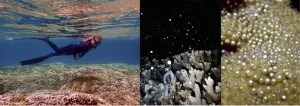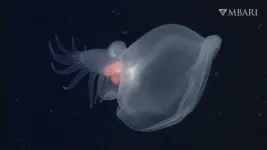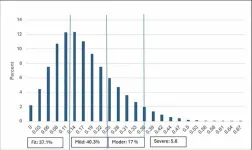(Press-News.org) Strabismus, a misalignment of the eyes that occurs especially in children, has no bearing on intelligence or personality, but animated movies tend to use the condition to signify a villainous, dopey, or clumsy character, according to a new study from researchers at the University of Colorado School of Medicine.
“When animators are figuring out what a character is going to look like, they have to decide on every little detail of that character's appearance, and so it's not by chance that an animated character happens to have strabismus,” says Michael Puente, MD, assistant professor of ophthalmology who focuses on pediatric ocular health. “That's something that the animation team made a deliberate decision to do, and I imagine that they have reasons for that decision.”
“Our study suggests that commonly, the reason that a character is depicted as having strabismus is if that character is unintelligent or undesirable, and that animators see strabismus as a way of visually conveying that undesirable trait,” he continues.
The research, published this month in the journal Pediatrics, analyzed 46 characters from animated 125 films made by Walt Disney, Pixar, DreamWorks and Studio Ghibli, and found characters with strabismus were 14 times more likely to be depicted as unintelligent than intelligent and six times more likely to be followers than leaders.
These depictions, the researchers say, can have harmful effects for children with strabismus by perpetuating stereotypes that can negatively affect a patient’s self-confidence and influence the perception of strabismus by young impressionable audiences.
The role of strabismus in mental development
There are several causes for strabismus, which can look like crossed eyes or one of the eyes drifting toward the ear. For some young patients, the condition can be a sign that they need glasses, but for most it’s a neurological issue where the signals from the brain to the muscles that control the eyes are not calibrated correctly, causing some of the eye muscles to pull too hard or not enough.
Surgery can help address those muscles and is successful about 80% of the time, Puente says. Often, he encounters young patients who ask for the surgery because they are self-conscious about their appearance.
“Every day I have kids that are asking me for surgery, and that says a lot as children tend to be apprehensive of medical care,” he says. “But strabismus often affects these kids so much that they’re asking for a fix. I don’t think there are a lot of other pediatric surgeons that have that experience.”
While strabismus can have impacts on a child's visual development, it also impacts the way that they interact with society, their peers, teachers, and their friends.
“Kids with strabismus, unfortunately get bullied a lot for that difference in appearance,” Puente says. “There have been studies that find that they're less likely to get invited to birthday parties. Kids in school are less willing to sit next to a kid with strabismus. There have been surveys of teachers that have found that teachers tend to assume that students with strabismus are less intelligent, and all this stigma affects the way that children develop psychosocially.”
Trends translating to reality
Negative perceptions in media can contribute and magnify these stereotypes, Puente and his fellow researchers say. They weren’t able to find a single primary protagonist with strabismus, however comic-relief characters or villainous characters with strabismus were common.
Researchers found only three characters that were considered “leaders,” but one was a villain and the other was depicted as “unintelligent.” In 125 films and 46 characters with strabismus, there was only one that was found to be intelligent, the character Forrest Woodbush from Pixar’s The Good Dinosaur.
Puente says he hopes the study can shine a light on how pervasive negative depictions are in media created for children and show animators how it affects young patients.
“If animators recognize that they tend to always portray strabismus so negatively, I hope they can reflect on that and maybe when they have an undesirable character or a bad guy or a ‘dumb’ character, they think twice before giving it strabismus,” Puente says. “It sends a message to their very young, impressionable audience.”
“There are lots of people with strabismus, and it would be great to have some characters with strabismus that could be role models and are portrayed positively,” he continues. “That just doesn’t exist in any of these movies in our study, but I think that would be a really impactful change.”
END
Animated movie characters with strabismus are more likely to be villains, study finds
CU researchers found characters with crossed or drifting eyes are more likely to play more minor roles in animated movies and be considered unintelligent or villainous.
2024-11-12
ELSE PRESS RELEASES FROM THIS DATE:
How retailers change ordering strategy when a supplier starts its own direct channel
2024-11-12
Researchers from Erasmus University and KU Leuven published a new Journal of Marketing study that examines how retailers respond when suppliers establish direct channels to reach end-consumers and how suppliers can take steps to avoid a backlash.
The study, forthcoming in the Journal of Marketing, is titled “How Retailers Change Ordering Strategies When Suppliers Go Direct” and is authored by Michiel Van Crombrugge, Els Breugelmans, Femke Gryseels, and Kathleen Cleeren.
Recently, Sony began selling PlayStation products through its PlayStation Direct online store in the UK, ...
Young coral use metabolic tricks to resist bleaching
2024-11-12
Coral larvae reduce their metabolism and increase nitrogen uptake to resist bleaching in high temperatures, according to a study published November 12th in the open-access journal PLOS Biology by Ariana S. Huffmyer of the University of Washington, US, and colleagues.
High ocean temperatures cause coral bleaching, which results from the disruption of the relationship between corals and their symbiotic algae, an increasing concern as global temperatures rise. However, relatively little research has examined the effects of high temperatures ...
Protecting tax whistleblowers pays off
2024-11-12
AUSTIN, Texas — The federal tax gap — money people and companies owe Uncle Sam but fail to pay on time — has climbed to historic highs: $696 billion in 2022, according to the IRS. It’s money that, if recouped, could fund infrastructure or education or pay down government debt.
One way to collect that money is through lawsuits prompted by corporate whistleblowers — often present or former employees who know a company’s finances and expose its transgressions.
Federal law includes ...
Bioluminescent proteins made from scratch enable non-invasive, multi-functional biological imaging
2024-11-12
Bioluminescence is the natural chemical process of light creation in some living creatures that makes fireflies flicker and some jellyfish glow. Scientists have long been interested in borrowing the secrets of these animals' light-producing genes to create similar effects in vertebrates, for a variety of biomedical applications.
UC Santa Cruz Assistant Professor of Biomolecular Engineering Andy Yeh is designing completely artificial proteins that produce bioluminescence to serve as a non-invasive method for bioimaging, diagnostics, drug discovery, and more. A new paper published in the flagship journal Chem reports on a new series of bioluminescent ...
New study links air pollution with higher rates of head and neck cancer
2024-11-12
DETROIT — A recent study published in the journal Scientific Reports correlates higher levels of pollutant particulate matter to higher occurrences of head and neck aerodigestive cancer.
The article, "Air Pollution Exposure and Head and Neck Cancer Incidence," is the work of a multi-institutional collaboration with researchers from Wayne State University, Johns Hopkins University and Mass General Brigham.
The study was led by John Cramer, Ph.D., associate professor of otolaryngology, and John Peleman, M.D., medical resident in the Department of Otolaryngology, in the Wayne State University School of Medicine. They collaborated with Mass General Brigham, an integrated ...
LSU researchers excavate earliest ancient Maya salt works
2024-11-12
The team was led by LSU Alumni Professor Heather McKillop, who first discovered wooden buildings preserved there below the sea floor, along with associated artifacts, and the only ancient Maya wooden canoe paddle in 2004.
Her key collaborator, Assistant Professor Elizabeth Sills at the University of Texas at Tyler, began working with McKillop as a master’s student and then as a doctoral student at LSU.
Since their initial discovery of wood below the sea floor in Belize, the team has uncovered an extensive pattern of sites that include “salt kitchens” for boiling ...
Building a diverse wildland fire workforce to meet future challenges
2024-11-12
Every year around this time, California’s wildland firefighters hold their breath as hot, dry winds threaten to spread flames across the state. As such conflagrations grow in size and severity throughout the Western U.S., the strain on fire managers has intensified. A new report from Stanford University’s Climate and Energy Policy Program provides a blueprint for fostering a more inclusive, diverse and well-supported workforce to meet the increasing need for fire mitigation and management.
“The wellbeing of the wildland fire workforce has ...
MBARI researchers discover remarkable new swimming sea slug in the deep sea
2024-11-12
MBARI researchers have discovered a remarkable new species of sea slug that lives in the deep sea. Bathydevius caudactylus swims through the ocean’s midnight zone with a large gelatinous hood and paddle-like tail, and lights up with brilliant bioluminescence. The team published a description of the animal, nicknamed the “mystery mollusc,” in the journal Deep-Sea Research Part I.
“Thanks to MBARI’s advanced underwater technology, we were able to prepare the most comprehensive description of a deep-sea animal ever made. We’ve ...
Decentralized social media ‘increases citizen empowerment’, says Oxford study
2024-11-12
Researchers from the Oxford Martin Programme on Ethical Web and Data Architectures (University of Oxford) have reported findings from a paper exploring the motivations and challenges in running decentralised social media such as Mastodon, concluding such platforms offer potential for increased citizen empowerment in this digital domain.
In their study, presented at the 27th ACM SIGCHI Conference on Computer-Supported Cooperative Work & Social Computing (CSCW) today, the researchers interviewed 16 administrators of Mastodon servers (otherwise known as instances), including those supporting marginalised and stigmatised communities. Their ...
Validating an electronic frailty index in a national health system
2024-11-12
“The classification of patients according to their level of frailty allows us to adjust prevention programs and focus our limited resources on the right action for the right person.”
BUFFALO, NY- November 12, 2024 – A new research paper was published in Aging (listed by MEDLINE/PubMed as "Aging (Albany NY)" and "Aging-US" by Web of Science), on October 24, 2024, Volume 16, Issue 20, titled, "Development and validation of an electronic frailty index in a national health ...
LAST 30 PRESS RELEASES:
Making lighter work of calculating fluid and heat flow
Normalizing blood sugar can halve heart attack risk
Lowering blood sugar cuts heart attack risk in people with prediabetes
Study links genetic variants to risk of blinding eye disease in premature infants
Non-opioid ‘pain sponge’ therapy halts cartilage degeneration and relieves chronic pain
AI can pick up cultural values by mimicking how kids learn
China’s ecological redlines offer fast track to 30 x 30 global conservation goal
Invisible indoor threats: emerging household contaminants and their growing risks to human health
Adding antibody treatment to chemo boosts outcomes for children with rare cancer
Germline pathogenic variants among women without a history of breast cancer
Tanning beds triple melanoma risk, potentially causing broad DNA damage
Unique bond identified as key to viral infection speed
Indoor tanning makes youthful skin much older on a genetic level
Mouse model sheds new light on the causes and potential solutions to human GI problems linked to muscular dystrophy
The Journal of Nuclear Medicine ahead-of-print tip sheet: December 12, 2025
Smarter tools for peering into the microscopic world
Applications open for funding to conduct research in the Kinsey Institute archives
Global measure underestimates the severity of food insecurity
Child survivors of critical illness are missing out on timely follow up care
Risk-based vs annual breast cancer screening / the WISDOM randomized clinical trial
University of Toronto launches Electric Vehicle Innovation Ontario to accelerate advanced EV technologies and build Canada’s innovation advantage
Early relapse predicts poor outcomes in aggressive blood cancer
American College of Lifestyle Medicine applauds two CMS models aligned with lifestyle medicine practice and reimbursement
Clinical trial finds cannabis use not a barrier to quitting nicotine vaping
Supplemental nutrition assistance program policies and food insecurity
Switching immune cells to “night mode” could limit damage after a heart attack, study suggests
URI-based Global RIghts Project report spotlights continued troubling trends in worldwide inhumane treatment
Neutrophils are less aggressive at night, explaining why nighttime heart attacks cause less damage than daytime events
Menopausal hormone therapy may not pose breast cancer risk for women with BRCA mutations
Mobile health tool may improve quality of life for adolescent and young adult breast cancer survivors
[Press-News.org] Animated movie characters with strabismus are more likely to be villains, study findsCU researchers found characters with crossed or drifting eyes are more likely to play more minor roles in animated movies and be considered unintelligent or villainous.




